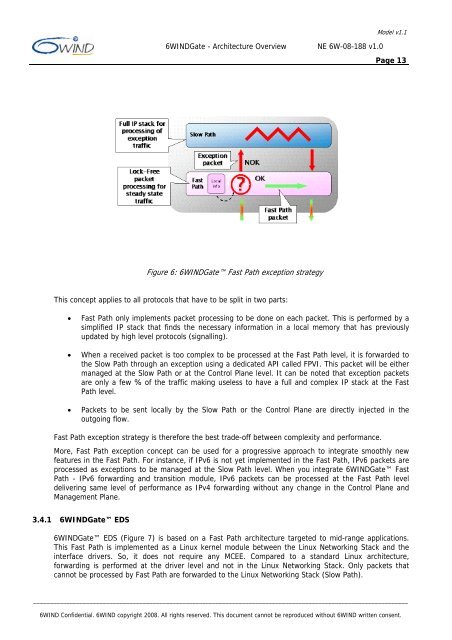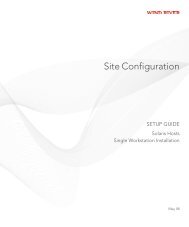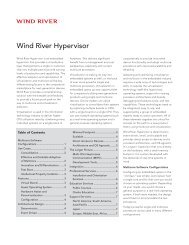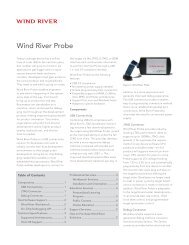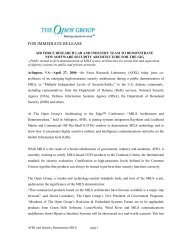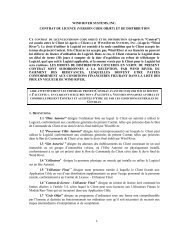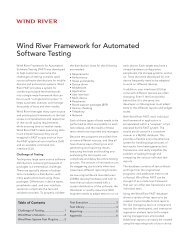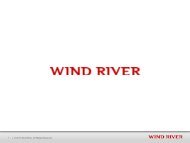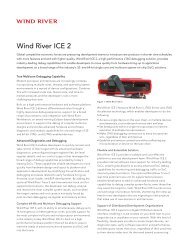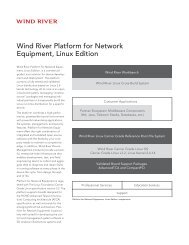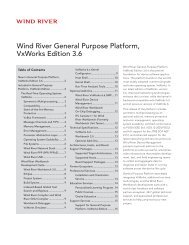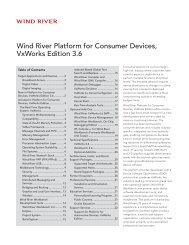6WINDGate™ - Architecture Overview - NE 6W-08-188 ... - Wind River
6WINDGate™ - Architecture Overview - NE 6W-08-188 ... - Wind River
6WINDGate™ - Architecture Overview - NE 6W-08-188 ... - Wind River
Create successful ePaper yourself
Turn your PDF publications into a flip-book with our unique Google optimized e-Paper software.
<strong>6W</strong>INDGate - <strong>Architecture</strong> <strong>Overview</strong> <strong>NE</strong> <strong>6W</strong>-<strong>08</strong>-<strong>188</strong> v1.0<br />
Figure 6: <strong>6W</strong>INDGate Fast Path exception strategy<br />
This concept applies to all protocols that have to be split in two parts:<br />
Model v1.1<br />
Page 13<br />
• Fast Path only implements packet processing to be done on each packet. This is performed by a<br />
simplified IP stack that finds the necessary information in a local memory that has previously<br />
updated by high level protocols (signalling).<br />
• When a received packet is too complex to be processed at the Fast Path level, it is forwarded to<br />
the Slow Path through an exception using a dedicated API called FPVI. This packet will be either<br />
managed at the Slow Path or at the Control Plane level. It can be noted that exception packets<br />
are only a few % of the traffic making useless to have a full and complex IP stack at the Fast<br />
Path level.<br />
• Packets to be sent locally by the Slow Path or the Control Plane are directly injected in the<br />
outgoing flow.<br />
Fast Path exception strategy is therefore the best trade-off between complexity and performance.<br />
More, Fast Path exception concept can be used for a progressive approach to integrate smoothly new<br />
features in the Fast Path. For instance, if IPv6 is not yet implemented in the Fast Path, IPv6 packets are<br />
processed as exceptions to be managed at the Slow Path level. When you integrate <strong>6W</strong>INDGate Fast<br />
Path - IPv6 forwarding and transition module, IPv6 packets can be processed at the Fast Path level<br />
delivering same level of performance as IPv4 forwarding without any change in the Control Plane and<br />
Management Plane.<br />
3.4.1 <strong>6W</strong>INDGate EDS<br />
<strong>6W</strong>INDGate EDS (Figure 7) is based on a Fast Path architecture targeted to mid-range applications.<br />
This Fast Path is implemented as a Linux kernel module between the Linux Networking Stack and the<br />
interface drivers. So, it does not require any MCEE. Compared to a standard Linux architecture,<br />
forwarding is performed at the driver level and not in the Linux Networking Stack. Only packets that<br />
cannot be processed by Fast Path are forwarded to the Linux Networking Stack (Slow Path).<br />
_________________________________________________________________________________________________________________<br />
<strong>6W</strong>IND Confidential. <strong>6W</strong>IND copyright 20<strong>08</strong>. All rights reserved. This document cannot be reproduced without <strong>6W</strong>IND written consent.


